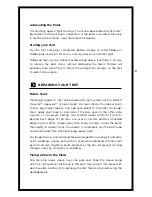
lubricating the poles
Occasionally apply a light coating of a silicone-based lubricant like 303
TM
protectant to the tent pole connections. If the poles are used extensively
in marine environments, treat them more frequently.
storing your Tent
Dry the tent and poles completely before storage to avoid mildew or
hidden pole corrosion. Store in a cool, dry place out of direct light.
Mildewed tents can be cleaned as described above, but there is no way
to remove the dark stains without damaging the fabric. Mildew will
probably take some time to affect the waterproof coatings, so the tent
should still be usable.
REpAiRiNg YOuR TENT
Fabric Tears
Watertight repairs to rips can be made with seam sealant such as McNett
Freesole
TM
, Aquaseal
TM
, or Seam Grip®. For tears shorter than about 1.5cm
(1/2in.), apply duct tape to one side and sealant to the other. On longer
tears, apply duct tape to one side of the tear and, on the other side,
a patch of no-see-um netting that extends about 6-12mm (1/4-1/2in.)
beyond each edge of the tear. Use oval or circular patches (rounded
edges are less likely to peel away than sharp corners). Cover the patch
thoroughly in sealant. Once the sealant is completely dry, the duct tape
can be removed from small and large repairs alike.
For longer trips, we recommend taking an expedition sewing kit and extra
nylon, webbing, a spare pole section, and narrow-diameter (2.5mm) tent
pole shockcord. Coghlan’s Seam Saturant or the like will prevent wicking
through a tent fly via seams or webbing.
Fixing a pole in the Field
Slip the pole repair sleeve over one pole end. Slide the sleeve along
until it is centred over the break in the pole, then wrap it into place with
duct tape. Be careful not to damage the tent fabrics when removing the
damaged pole.
Summary of Contents for Frontenac
Page 10: ......




























